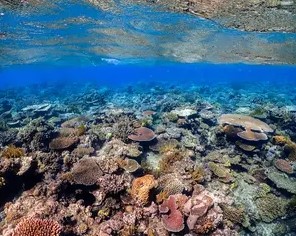Syllabus:
GS-3: Conservation, environmental pollution and degradation, environmental impact assessment
Context: The IUCN World Heritage Outlook 4 was released at the 2025 IUCN Congress in Abu Dhabi which assesses the condition and threats faced by natural World Heritage sites globally.
Key Findings
• Climate Change as the Primary Threat:
- Climate change threatens 43% of natural World Heritage sites with high or very high risk.
- Causes include rising sea levels, more frequent storms, temperature rise, glacial retreat, droughts, wildfires.
• Impact of Invasive Species and Diseases:
- 30% of sites affected by invasive alien species causing habitat degradation.
- Wildlife and plant diseases affect 9% of sites, up from 2% in 2020.
• Declining Conservation Outlook:
- Positive conservation outlook dropped from 62% in 2020 to 57% in 2025.
- Only half of 271 assessed sites have effective protection and management.
- 15% of sites face serious financial shortfalls weakening conservation capacity.
- 49% of UNESCO Natural World Heritage Sites in Asia have management effectiveness rated as ‘some concern’.
• Regional Situation: India:
- Sundarbans National Park status downgraded to ‘Significant Concerns’ due to salinity, contamination, resource extraction, sea level rise affecting mangroves.
- Manas National Park and Western Ghats remain in ‘Significant Concern’ category.
- Great Himalayan National Park, Kaziranga, Keoladeo, Nanda Devi, Valley of Flowers are ‘Good with Some Concerns’.
- Khangchendzonga National Park remains ‘Good’ in conservation outlook.
• Indigenous Peoples’ Role:
- Indigenous leadership and knowledge highlighted as key for biodiversity improvement and site resilience.
- Examples include ranger groups and community-led conservation efforts.
• Progress and Success:
- Since 2020, 13 sites improved conservation outlook, including four in West and Central Africa.
- Success attributed to better anti-poaching policies, community partnerships, and wildlife stabilization.
Key Recommendations
• Increase investment in climate adaptation and mitigation for vulnerable ecosystems.
• Strengthen governance and management capacity at site and regional levels.
• Address financial shortfalls to sustain conservation efforts.
• Promote Indigenous Peoples’ rights and incorporate their knowledge in conservation.
• Enhance monitoring and predictive tools to tackle invasive species and pathogens.
• Need for the ‘One Health’ approach encompassing people, species and ecosystems.
About the Report
• It is the most comprehensive assessment of all natural World Heritage sites globally, and for the first time reveals trends in the conservation prospects of these sites over a ten-year period.
• The earlier publications of the IUCN World Heritage Outlook include the first edition in 2014, followed by the second in 2017 and the third in 2020.
• The report reviews major conservation challenges facing natural World Heritage sites and tracks changes over the past decade.
• It categorises sites by conservation outlook: good, good with some concerns, significant concern, and critical.
• It presents global findings on natural values, threats, and management effectiveness.
Sources:
Down to Earth
DD News
IUCN

